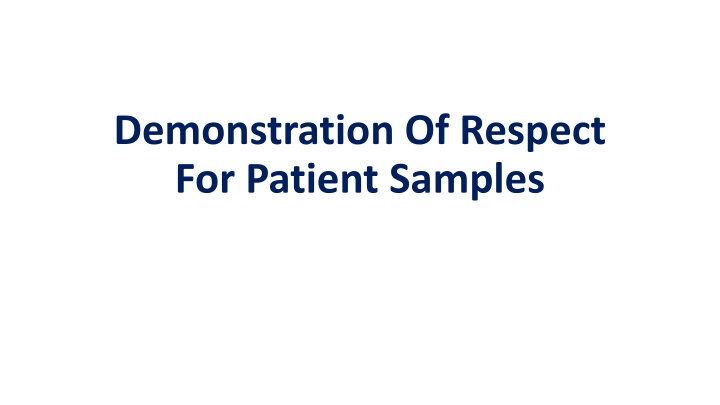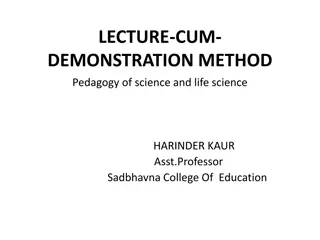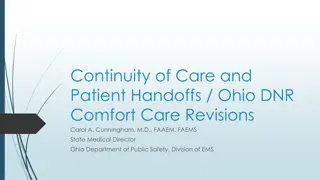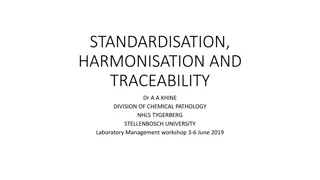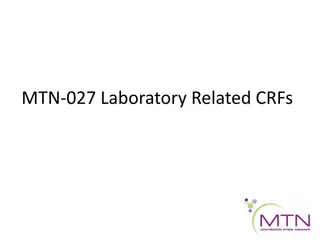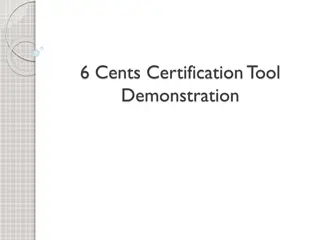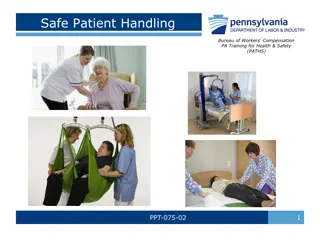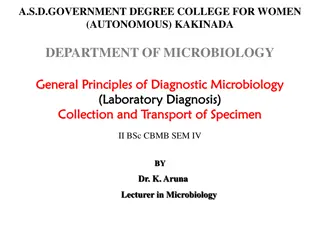Demonstration of Respect for Patient Samples in Laboratory Settings
Demonstrating respect for patient samples in the laboratory is crucial to ensure accurate testing and diagnosis. This includes proper handling, transportation, and documentation of specimens. Case scenarios highlight the impact of mishandling samples, leading to rejected, misplaced, or misinterpreted results. These incidents underline the importance of adherence to protocols and communication among healthcare providers for optimum patient care.
Download Presentation

Please find below an Image/Link to download the presentation.
The content on the website is provided AS IS for your information and personal use only. It may not be sold, licensed, or shared on other websites without obtaining consent from the author.If you encounter any issues during the download, it is possible that the publisher has removed the file from their server.
You are allowed to download the files provided on this website for personal or commercial use, subject to the condition that they are used lawfully. All files are the property of their respective owners.
The content on the website is provided AS IS for your information and personal use only. It may not be sold, licensed, or shared on other websites without obtaining consent from the author.
E N D
Presentation Transcript
Demonstration Of Respect For Patient Samples
Competency Demonstration of respect for patient samples sent to the laboratory for performance of laboratory tests in the detection of microbial agents causing infectious diseases
1. Rejection due to improper transport Sequestrum from a chronic osteomyelitis case was debrided and sent for culture and sensitivity The sample was rejected by the laboratory mentioning that it was received in formalin, hence unsuitable for culture There is no more sample available for culture now
2. Specimen did not reach the laboratory A critically ill 5 year old child s CSF report is awaited for 3 days On enquiry, laboratory says it did not receive the sample On further probing, it was found that the nursing staff had kept the sample container in his pocket and mistakenly taken it outside the hospital and had dropped it somewhere, and did not submit it to the laboratory for testing Now the baby needs to undergo lumbar puncture again, results may not be the same as antibiotics are give and need to wait for some more days for the culture report
3. information in requisition form Misguided report due to inadequate Urologist calls up the laboratory to discuss about insignificant bacteriuria culture report of a pyelonephritis patient He says it was a percutaneous nephrostomy sample and asks for the organism and antimicrobial sensitivity Microbiologist says it was written as urine sample on the request form, some gram negative bacillus had grown and the count was less than 10,000 CFU/ml, so it was thought to be a periurethral commensal and the isolates was discarded and hence further testing can not be done
4. Rejection due to improper collection A suspected pulmonary tuberculosis patient, who would travel 30 km from his village to the private hospital in the city, had submitted spot sputum sample the previous day and an early morning sample today for acid fast staining Reports of both the samples mentioned many epithelial cells s/o excessive salivary contamination , repeat with the proper sample The doctor found it very difficult to convince the patient to submit proper samples again and pay for them too
Essential background knowledge Essential background knowledge 1. Appropriate sample for test planned: sample type, amount, collection procedure, preservative if any, container type used and its transportation and storage 2. Appropriate labelling for correct sample identification 3. Accompanying clinical information for correlation 4. Possible incomplete/incorrect information for correlation, proper storage or transportation medicolegal/Sociocultural/Ethical sample issues relevant following clinical identification,
Specific learning objectives Specific learning objectives 1. Choose an appropriate container for sample collection 2. Demonstrate an appropriate procedure for temporary storage and transportation of clinical sample 3. Discuss the information that shall be written in the request form and the sample container, completely and legibly 4. Discuss the judicious application of sample rejection criteria in the best interest of patient care 5. Discuss the importance of prioritizing the specimen as relevant to the clinical situation 6. Discuss medical, ethical and socio-economical consideration of errors in sample collection and submission issues
Types of infections and various specimens collected Types of infections specimen Container Bloodstream infections Paired blood culture specimens Blood culture bottle Infectious diseases requiring serology blood Vacutainer Diarrheal diseases Stool Universal container Swab Rectal swab meningitis CSF Universal container Infections of sterile body area Sterile body fluids Universal container Skin and soft tissue infections Pus or exudate Universal container Upper respiratory tract infections Throat swab, nasopharyngeal swab, pernasal swab Swab stick
Types of infections and various specimens collected Types of infections specimen container Lower respiratory tract infections Sputum, endotracheal aspirate, BAL Universal container Pulmonary tuberculosis Sputum: early morning and spot Universal container Urinary tract infections Midstream urine Suprapubic aspirate Universal container Genital infections Urethral swab, cervical swab, exudates from genital ulcers Swab stick Universal container Eye infections Conjunctival swab Swab stick Ear infections Swabs from outer ear Aspirate from inner ear Swab stick Universal container
Labelling All specimens must be appropriately labeled with Name Age Gender Identification no./CR no./ward/bed Name of the treating physician Clinical diagnosis Antibiotic history Type of specimen Date and time of sample collection Desired investigation name
Specimen transport Specimen should reach the laboratory for further processing as soon as possible after the collection Specimens such as CSF, ocular specimens, suprapubic aspirate and bone specimens should be transported immediately Urine should be transported within 2 hours and urine with added preservative is acceptable up to 24 hours Stool specimens should be transported within 1 hour, but with transport media it is acceptable up to 24 hours
Specimens storage before processing Blood cultures: should be incubated at 37 C immediately upon receipt Sterile body fluids, bone, vitreous fluid, suprapubic aspirate should be immediately plated upon and incubated at 37 C Corneal scraping should be immediately plated at bed side on to blood agar and chocolate agar Stool specimen for culture can be stored up to 72 hours at 4 C Urine, lower respiratory tract specimen, gastric biopsy can be stored up to 24 hours at 4 C
Prioritizing the specimens for processing Certain precious specimens such as CSF, and sterile body fluids, ocular specimens, tissue, suprapubic aspirate and bone specimens should be processed immediately as soon as received, not more than 15 mins delay Blood culture bottles should be immediately incubated upon receipt
Specimen rejection criteria Microbiology specimens that don t meet the appropriate sample and the test request requirements need to be rejected To prevent inaccurate data and to ensure the safety of patients and laboratory personnel Reasons for sample rejection may include:
Improperly labeled and unlabeled sample Mismatch of information on the label and the request Sub-optimal inappropriate sample for the test requested samples: leaky containers, insufficient quantity or sample with questionable relevance Duplicate microbiology samples received on the same day
Sample delay in transit more than the accepted limit Inappropriate transport temperature Inappropriate transport medium specimen received in a fixative (formalin)
